Original from Delphi Digital
Compiled by | Odaily Planet Daily Golem (@web3_golem)_
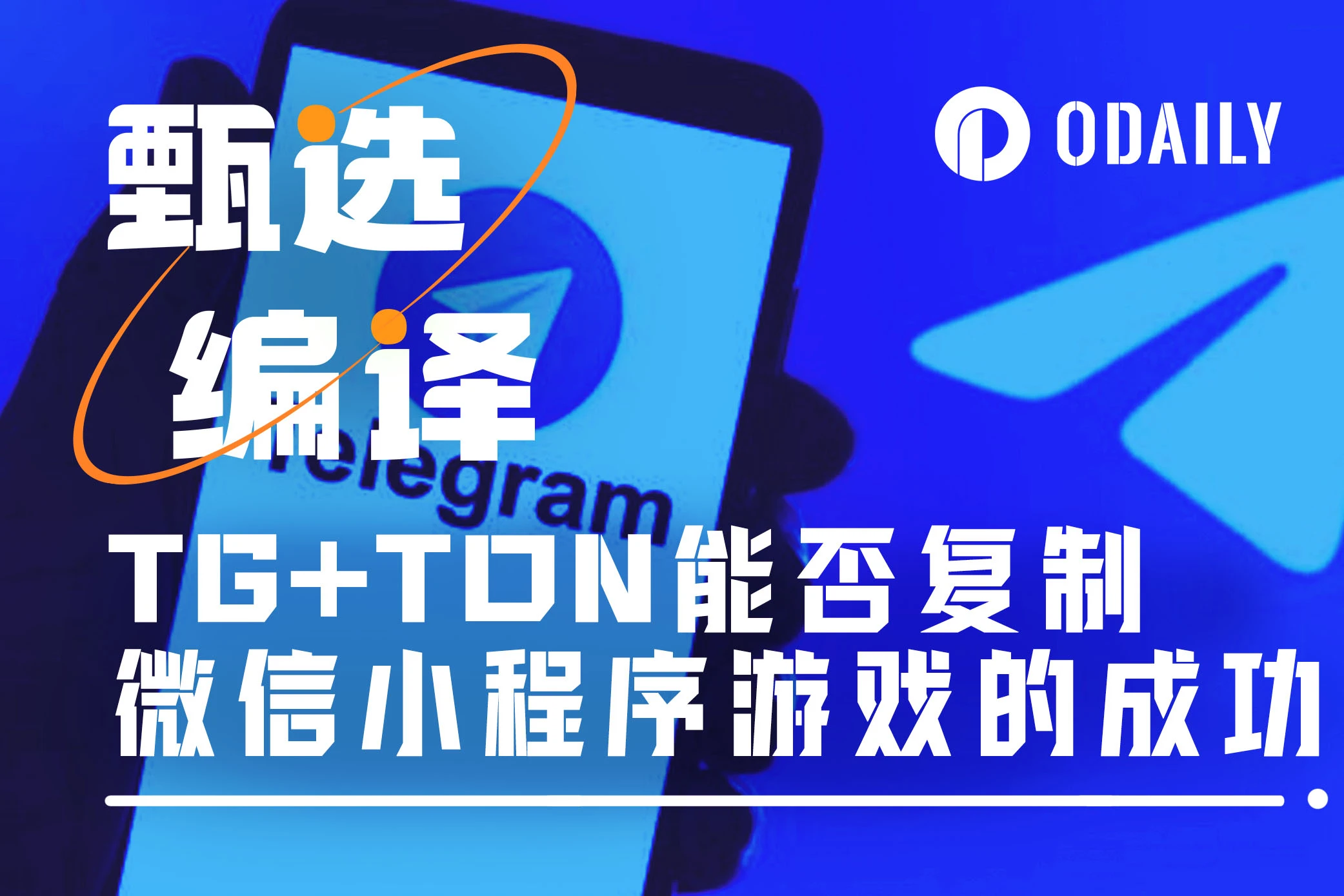 In the past few weeks, the most eye-catching in the Web3 gaming world is undoubtedly the TON ecosystem. From the initial NOT with no VC support opening at a FDV of over 10 billion US dollars, to Hamster Kombat reaching 142 million registered users in 77 days, and then to the Telegram-wide Meme airdrop of DOGS that went viral overnight this week, the TON ecosystem seems to have new milestones every week.
In the past few weeks, the most eye-catching in the Web3 gaming world is undoubtedly the TON ecosystem. From the initial NOT with no VC support opening at a FDV of over 10 billion US dollars, to Hamster Kombat reaching 142 million registered users in 77 days, and then to the Telegram-wide Meme airdrop of DOGS that went viral overnight this week, the TON ecosystem seems to have new milestones every week.
With 9 billion monthly active users, Telegram is one of the largest channels for converting users to Web3. Due to its greater security and privacy, Telegram, the fifth largest globally and second fastest growing communication tool, has become one of the main encrypted communication applications. Every non-US user automatically generates an abstract encrypted wallet when registering on Telegram, giving the TON ecosystem huge potential in driving mass adoption of Web3.
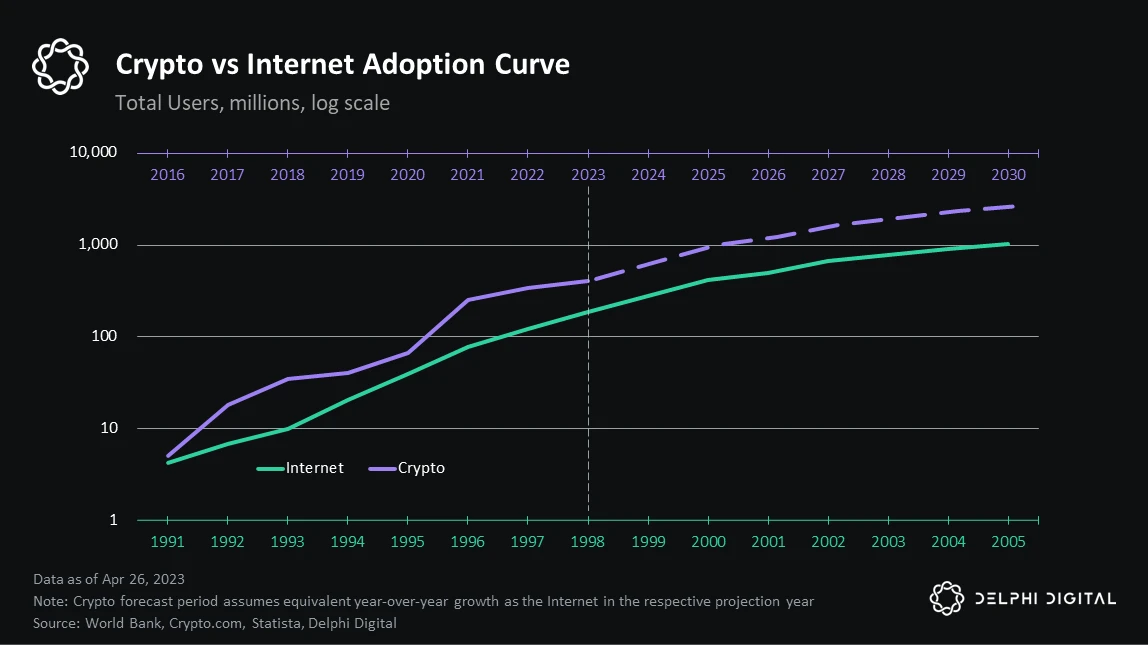
In this article, we will delve into the social games of Facebook and WeChat, then analyze the TON ecosystem, explore the unique aspects of Telegram in user acquisition, and finally answer a question: Can Telegram+TON replicate the success of WeChat mini programs, or is it just a Meme frenzy.
Social platforms and games
In 2010, the Internet became a public resource accessible to everyone, paving the way for the development of online social platforms. In order to retain users and profit from them, these platforms began to expand their business scope to include games, daily services, e-commerce, and many other areas.
Facebook—The beginning of the social gaming era
After the millennium, the user base of social platforms grew exponentially. In order to retain as many users as possible, they began to look for ways to entertain users. Games, due to their ease of dissemination, high scalability, and the ability to both consume a lot of time on the platform and quickly monetize, naturally became the optimal choice. Facebook, WeChat, and Telegram all allocated dedicated resources to build their own gaming departments. The benefits of large social platforms developing games are as follows:
Users can access richer content to enhance their core experience on the platform;
Games often have social attributes, encouraging competition and social activities;
Most games are casual and free, with characteristics of easy access, dissemination, low development costs, and fast iteration;
The social platforms themselves have a large user base, and their game distribution capabilities far exceed those of most game studios;
Games consume a lot of time for users, while providing huge consumption potential, increasing the overall user retention rate and lifetime value (LTV) of the platform.
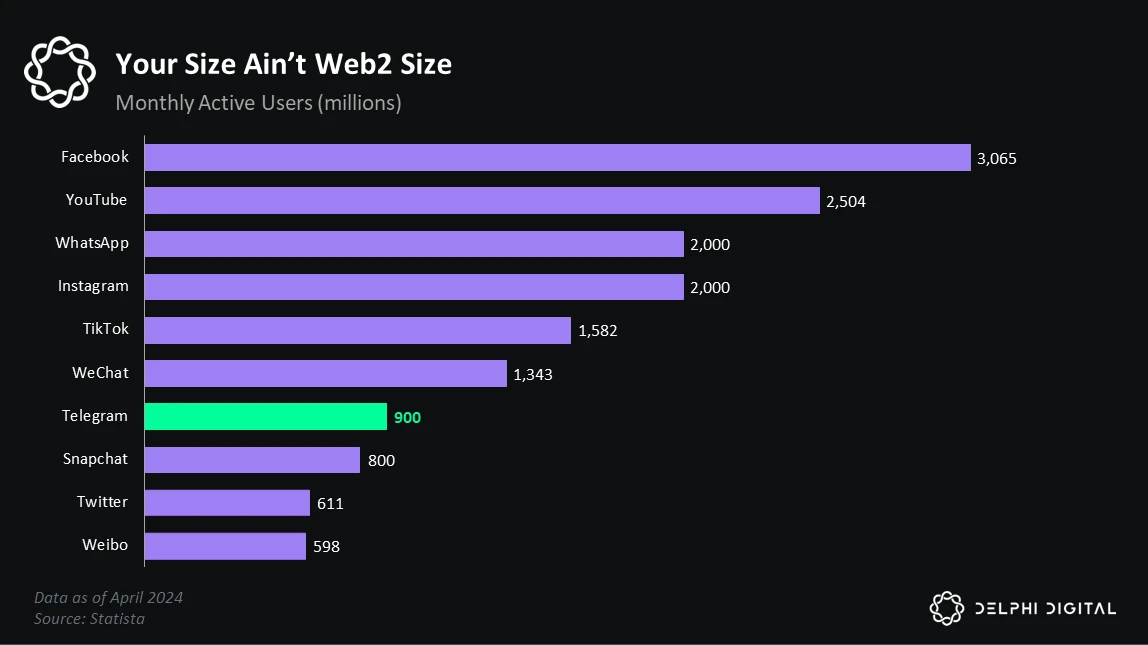
The expansion of Facebook's platform functionality marked the beginning of the social gaming era, with simple games gaining millions of daily active users (DAU) within weeks. The growth speed and scale of these social gaming ecosystems were rapid. Farmville, a social farm game developed by Zynga on Facebook, had 10 million monthly active users (MAU) just two months after its release, reaching a peak of 80 million MAU in 2010. Even three years after its release, the game still accounted for about 20% of Zynga's total revenue.
However, the social nature of these games often concentrated players on a few major titles. As players wanted to compete with friends and share their achievements, network effects eventually led players to a few major titles, such as Candy Crush, Farmville, and Zynga Poker, making it difficult for other latecomers and unknown games to succeed.
WeChat—More than just an instant messaging tool
Although most instant messaging apps have added social functions such as short videos and group chats over time, the level of user engagement and monetization achieved through alternative entertainment functions such as games is still limited. While there is nothing directly preventing game developers from developing games on the platform, as with early TikTok games, the lack of proper infrastructure and payment channels makes it both challenging and risky. The game industry's profits are meager, and most development teams are unwilling to restrict users to in-app purchases (IAP) due to unnecessary user friction.
However, as Facebook games gradually fade from people's sight, WeChat, the universal platform in China, continues to prove the huge growth potential of the intersection of social applications and games. WeChat can be seen as a super app, where users can chat, make calls, pay utility bills, order meals, book international trips, and more. 80% of Chinese users use it every month, spending an average of about 80 minutes on WeChat each day.
In 2017, WeChat launched mini-programs, allowing small applications to run natively within the app. Subsequently, WeChat introduced the first batch of mini-program games (developed by Tencent as first-party). Later in 2018, third-party developers were introduced, and by the end of the same year, the number of registered mini-games on WeChat exceeded 7,000.
Over the next few years, WeChat introduced several new supporting features and updates, ultimately making mini-games better, more perfect, and with more complex game mechanisms. By 2021, although the number of mini-program game developers far exceeded 100,000, the number of monthly active users (MAU) did not significantly increase since the feature was launched (MAU was about 20 million in 2017). New user acquisition is a significant issue for these mini-program games, and to address this, Tencent allows mini-program game developers to purchase advertising traffic across the entire Tencent ecosystem.
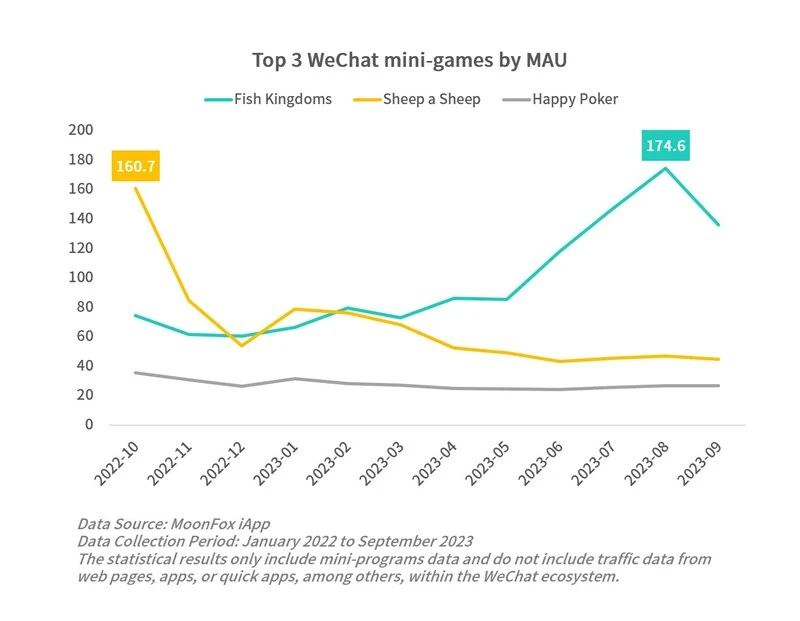
Source: Nasdaq | Top 3 WeChat mini-games by monthly active users
However, the effect was not significant until two other Chinese social platforms, Bilibili and Douyin, allowed ads to directly link users to WeChat mini-games, leading to a turning point. Subsequently, a series of popular games emerged, with a match-three style game "Sheep and Peace" leading the way, attracting 60 million daily active users within a month.
By June 2023, there were over 300,000 WeChat mini-program game developers, with over 400 million monthly active game players, accounting for about 31% of WeChat's total 1.3 billion users. In addition, the industry estimates the WeChat mini-program game market size to be $6 billion in 2023, with an expected annual growth rate of 25% to 30% over the next five years.
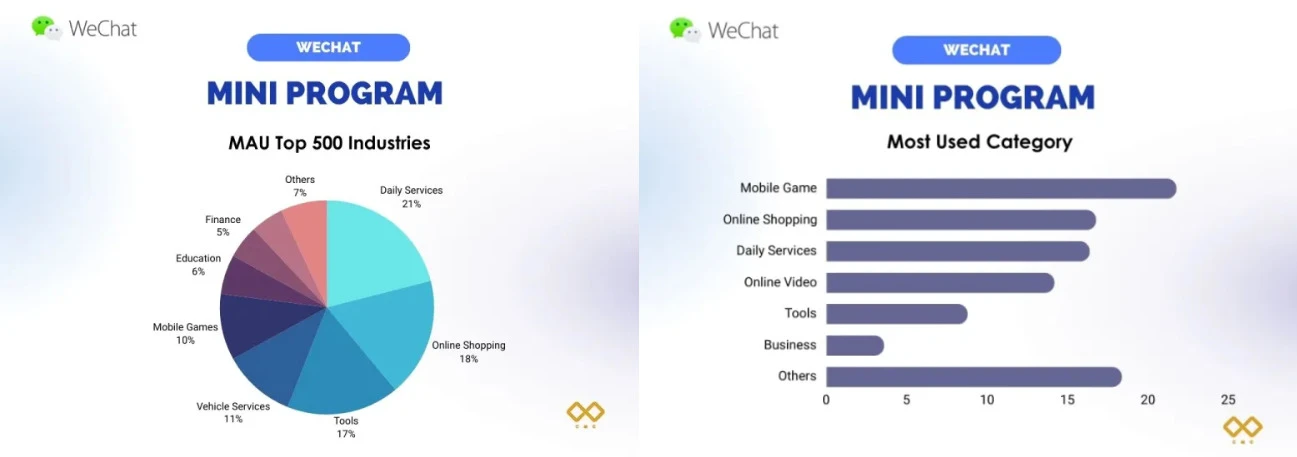
Source: Chinamarketingcorp
In the second quarter of 2023, the quarterly revenue of over 100 mini-program games reached 10 million RMB (1.38 million USD), with several games generating monthly revenue exceeding 15 million USD. The main reason is that compared to traditional mobile games, the profit margin of WeChat mini-games is much higher (>30%).
However, in terms of monthly active users, games only account for 10% in the top 500 of WeChat mini-programs. WeChat is still primarily a social app, followed by lifestyle service apps, and lastly, games, and so on. However, it is currently the most successful case of using games to increase user engagement and add new revenue streams on a highly integrated, almost frictionless platform.
With this background, we will now discuss Telegram, the TON Foundation, and the sudden explosion of Telegram mini-program games.
Telegram—Web3 Social Mini-Game Hub
Telegram was the first pure chat application to enter the gaming field. In 2016, Telegram bots integrated HTML5, and in 2017, the development of the TON blockchain further reduced friction between users and game developers. Through TON, developers can access payment channels, decentralized storage for storing game assets, or smart contracts for secure and automated game mechanisms, and efficiently distribute their games to a platform with 9 billion monthly active users.
TON Ecosystem
The TON technology stack provides developers with tools to develop various dApps on Telegram. Hundreds of teams are providing services for wallets, exchanges, cross-chain, games, and more market demands within the ecosystem.
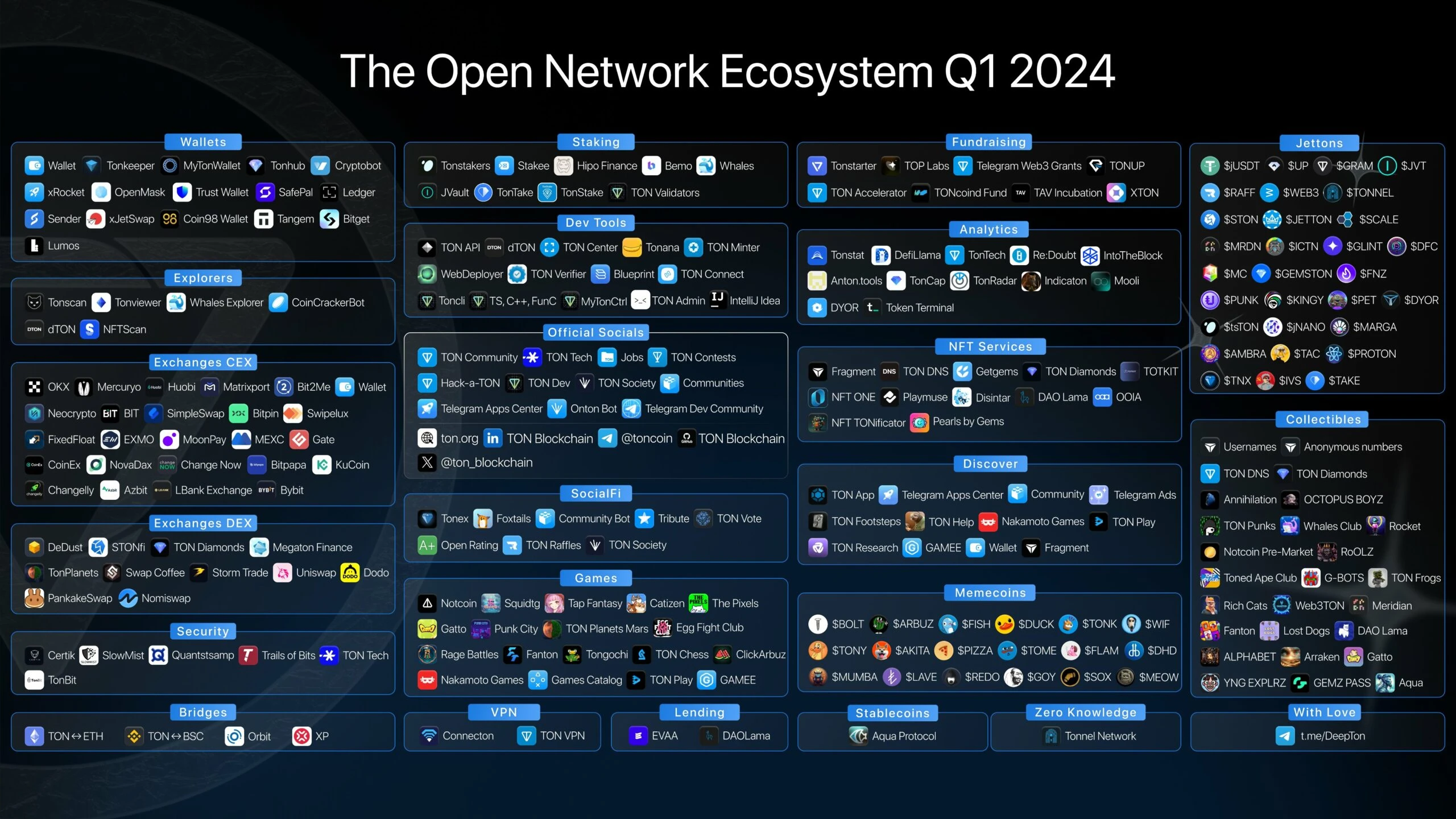
Source: X.com @dacrimeator
The TON token is at the core of the TON ecosystem. Firstly, it is the network gas consumption, where validators need to stake TON to participate in the POS validation process, similar to the ETH or SOL network. Additionally, developers need to pay TON to deploy and run smart contracts on the TON network. The total cost includes base fees, storage fees, and execution fees to ensure the scalability of the token and validator income.
At the same time, users and developers can exchange value within the ecosystem with minimal friction using TON. Although the TON token supply grows by a fixed 0.6% annually, 50% of the network fees are burned, incentivizing people to hold the token as an asset, whose value will expand with TON network activity. Using the burn rate in June 2024 as a benchmark, approximately 2.89 million TON are burned annually, accounting for 10% of the 30.65 million new TON entering the ecosystem through inflation in the next year.
To achieve decentralized decision-making, governance is distributed to TON holders based on the proportion of TON held. While governance is not the primary function of the token, it theoretically plays an important role as a supplementary function in shaping the future of the protocol. However, high centralization—where the top 100 holders hold 92% of the supply—greatly limits the role of decentralized decision-making through governance.
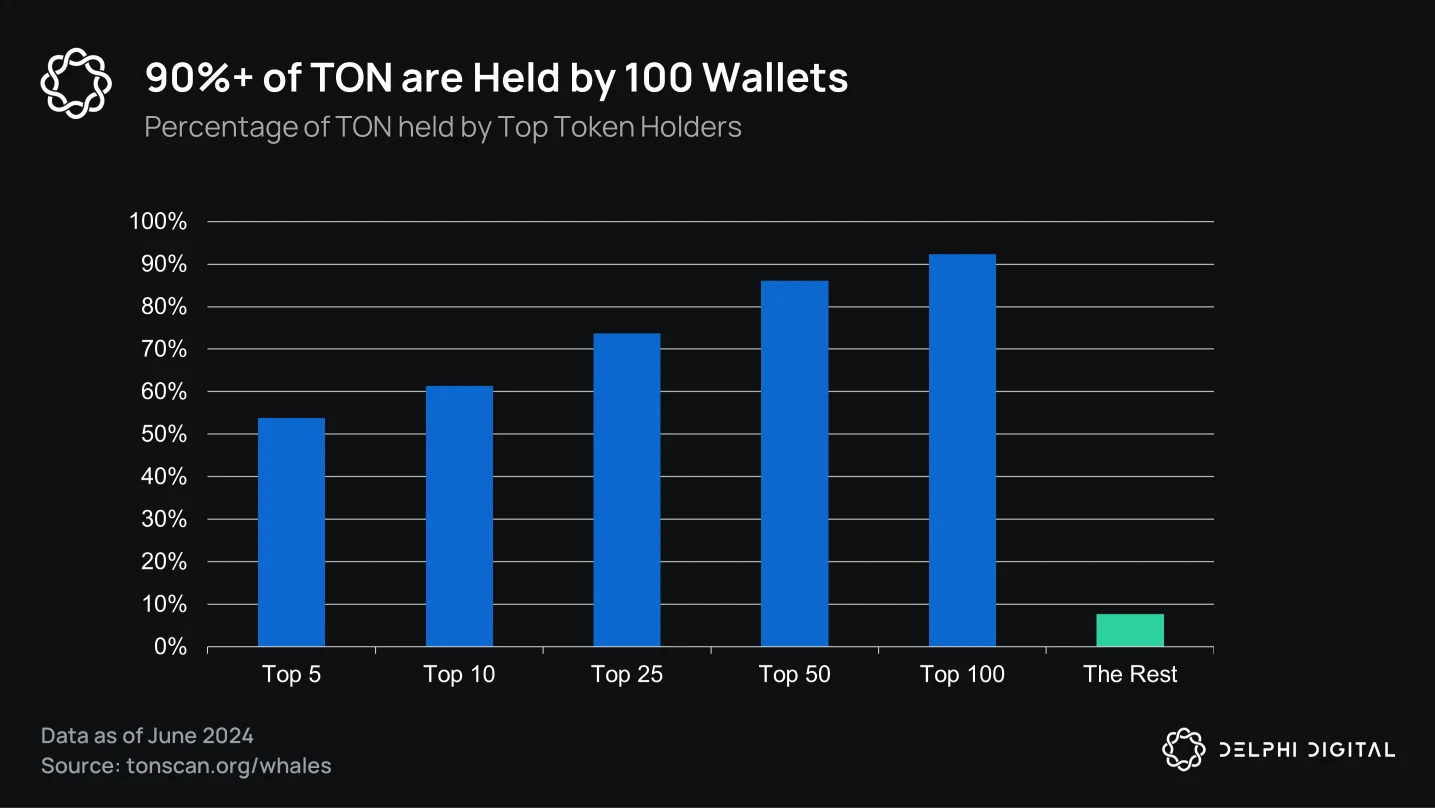
The Ton Believers Fund is the core community of TON believers. Over 1.3 billion TON has been locked in the fund for five years, accounting for about 25% of the total supply. In 2023, the fund stopped accepting deposits and began a two-year hard lockup period, after which the locked tokens and rewards will begin a three-year linear unlocking period. While locking a large supply for five years reflects the long-term belief of the TON community, it further centralizes governance. In addition, the incentive plan is not clear, as stakers' rewards come from "donations" and a proposal passed with a 99.4% approval rate, which approves the distribution of 1 million TON (0.1% of staked tokens) to stakers.
TON Gains Massive Attention
TON suddenly experienced explosive growth, with the ecosystem dApps breaking records. Notcoin reached 40 million users in six months, Hamster Kombat registered users exceeded 200 million, with over 30 million daily active users (DAU). This is similar to the rapid growth of early social games mentioned earlier (such as Farmville and Sheep and Peace), but this time it highlights the powerful role of cryptocurrency in growth incentives.

Source: Tokenterminal
In late February, Telegram announced that it would share 50% of its advertising revenue with channel owners through TON, which was a significant factor in gaining attention for TON. The convenient implementation of payment channels has opened up a huge potential market for advertisers, who can now access Telegram's massive user base. The TON token rose by 40% on the day of the announcement.
The developer community of the TON ecosystem steadily grew from the first quarter of 2022 to the fourth quarter of 2023. In the first quarter of 2022, the Telegram developer community for TON had about 2,200 users, which had risen to 13,500 by the fourth quarter of 2023. As of June 2024, the user count has grown by nearly 100%, reaching 36,500.
The number of Chinese developers has recently seen significant growth, increasing from over 2,300 to over 7,300, a growth of over 300%. In contrast, the Russian community only grew by about 50%, indicating the increasing interest of the Chinese community in TON and cryptocurrency.
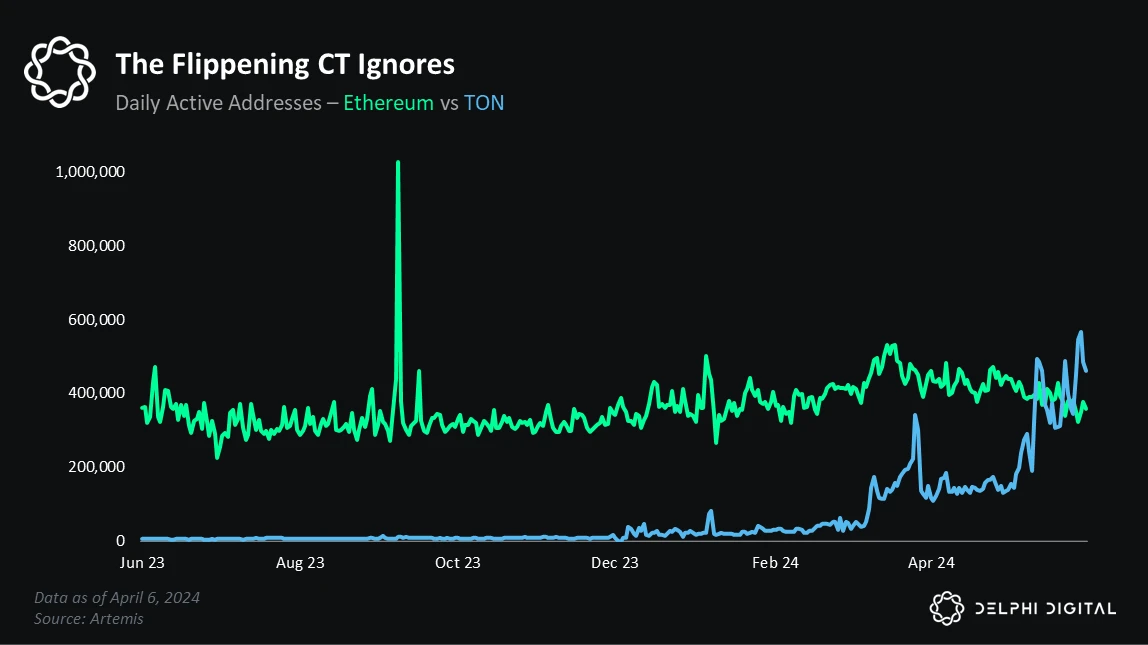
The daily active wallets and transaction volume of TON showed an upward trend in the second quarter, mainly driven by the popularity of Notcoin and Hamster Kombat. This trend is also reflected in the number of wallets, wallets activated on the chain, minted NFTs, and overall DAU. All activity indicators for TON have started to show exponential growth.
TON Growth Initiatives
The TON Foundation plays a key role in supervising and driving the development of the ecosystem. As a non-profit organization, its mission is to incentivize innovation for the benefit of the entire TON ecosystem. Supported by the $90 million ecosystem fund established in 2022 and the recently established $30 million TON Community Rewards Program, it has made various investments and grants to promote native dApps on TON.
Their accelerator program has gained significant attention since March. Out of the 82 proposals approved on Questbook, 17 were related to games or game infrastructure, making GameFi one of the most representative industries. TON recently announced a new $5 million TONX accelerator program, which will further drive the growth of TON.
Community incentives are an important part of TON's long-term growth strategy. Most programs last 2-4 weeks and are designed to be very easy to understand to attract as many participants as possible. So far, TON has distributed over $40 million, with many other programs ongoing or planned. In airdrops, LP bonuses, and The Open League rewards, $22.4 million has been distributed, with 17% ($3.9 million) allocated to games.
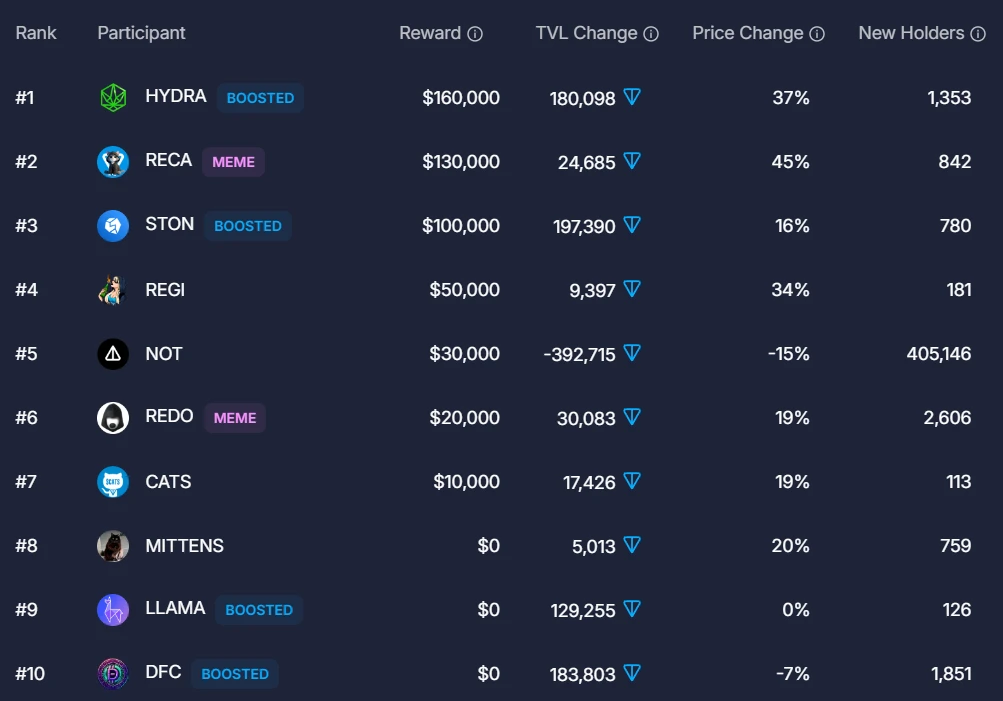
Source: ton.org
TON games have been very successful in these competitions and have occupied the top positions in the rankings. TAP Fantasy secured second place in the Beta season and won the championship in the subsequent first season. The champions of the second and third seasons were both won by Catizen, a game developed by a Chinese team with experience in WeChat mini-games.
Games are one of the main ways for TON to generate meaningful and sustainable user traffic. Teams like Catizen have been able to generate over $10 million in revenue through in-game purchases in the past three months, proving that teams with commercial experience can convert some hype-driven user metrics into meaningful revenue.
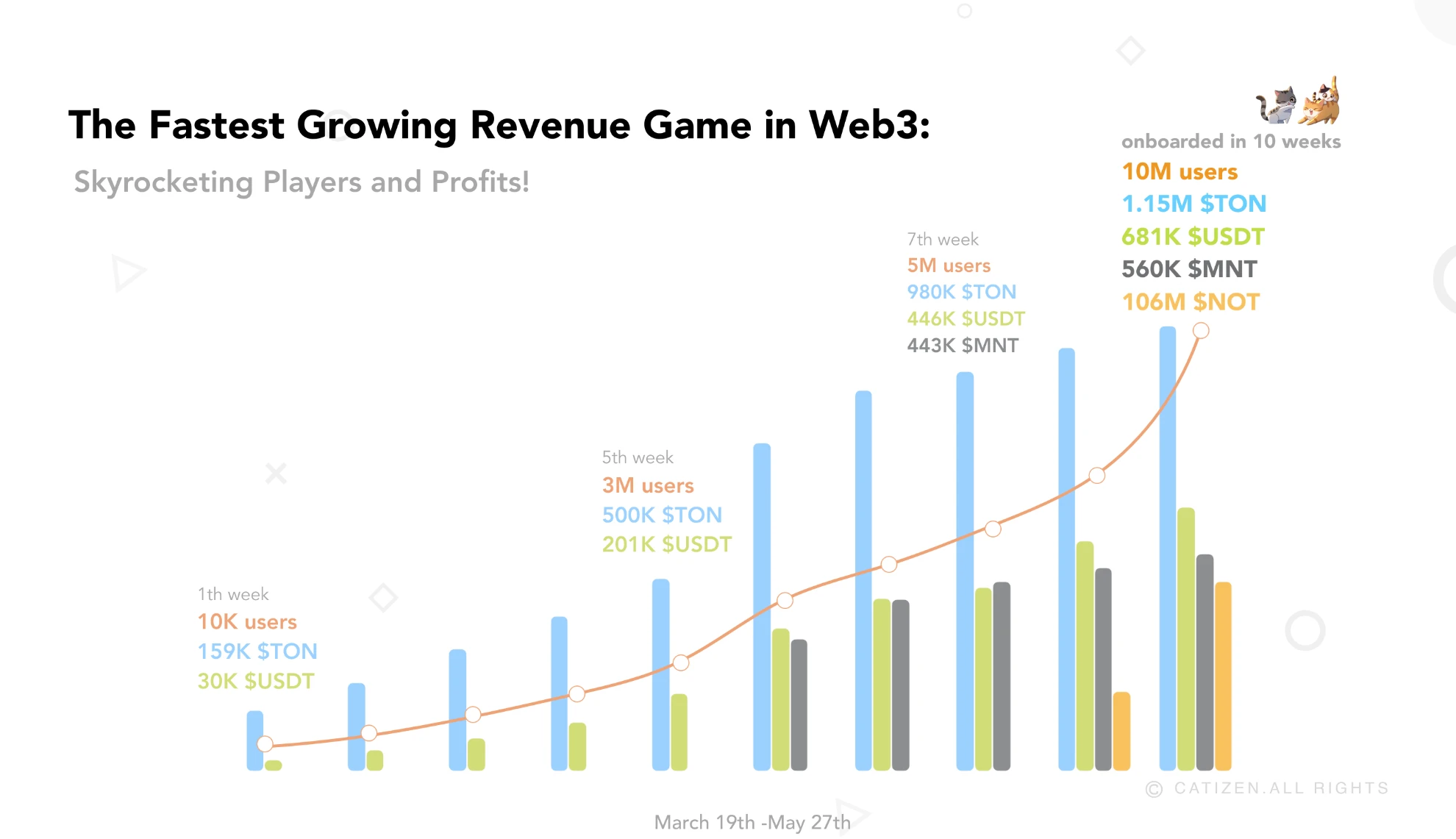
Source: Catize
Despite these impressive numbers, teams built on TON need to prove their ability to operate sustainably and convert free users into paying customers without the strategy of unlimited inflationary token rewards. Acquiring users is the first step, but retaining users requires continuous operation and content updates, especially in attention economies like Web3.
Additionally, bots are also a concern, and without effective countermeasures, token rewards will attract a large number of bots, diluting player rewards and increasing selling pressure after airdrops.
User Acquisition for Games
User acquisition (UA) has become a critical metric for any mobile game studio. In an exceptionally competitive industry with thin margins, expanding the user base is crucial for sustainable success. According to CNBC's calculations, the operating profit margin in the gaming industry is less than 6%, forcing companies to cut costs in all aspects.
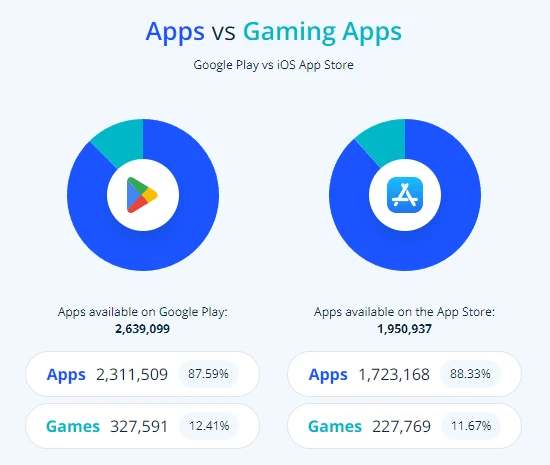
Source: 42matters
There are over 300,000 game applications in the Google Play Store and over 225,000 in the App Store. With so many games vying for approximately 2.2 billion global mobile game players, UA costs have sharply increased. In 2018, the cost per install (CPI) was about $1.24 for iOS and $0.53 for Android. Just six years later, iOS has risen to $2-5, and Android is $1.5-4.
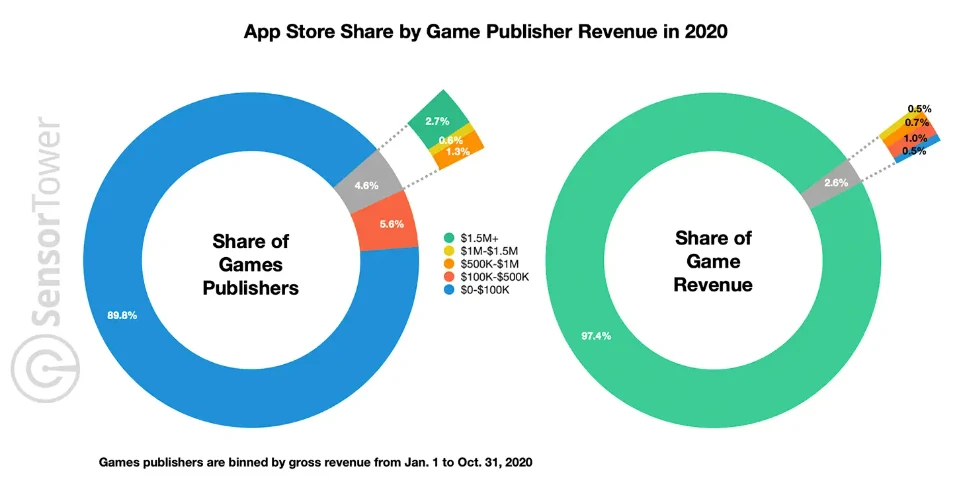
Source: SensorTower
According to Sensor Tower's report, in 2020, the revenue of over 28,000 mobile publishers was less than $1 million, totaling approximately $834 million (2% of the App Store game revenue). In contrast, the 940 studios with revenue exceeding $1 million accumulated $34 billion (98%), indicating that small studios unable to afford significant UA expenses are at a significant disadvantage. Considering that about 60% of game time is spent on games older than six years, it's not surprising that 83% of mobile games fail within three years of launch. For new mobile studios looking for sustainable development, efficient UA has become essential for survival.
To help developers in the increasingly competitive mobile market and further improve the transition from Web2 to Web3, Telegram recently launched stars, a native in-app purchase (IAP) currency that can be seamlessly integrated into bots and mini-games. Users can now seamlessly purchase in-game items with this currency, which complies with App Store regulations, unlocking deeper player spending and more stable revenue sources for developers, who will receive a 70% share of the IAP.
By subsidizing ads purchased with stars, Telegram enables teams to significantly reduce customer acquisition costs, making its Web3-friendly user base an attractive platform for Web3 marketing. Additionally, stars can be converted into TON tokens, effectively connecting them to a more liquid market. As long as the TON token remains stable, developers can have stable and efficient revenue.
Considering the continuously rising user acquisition costs for mobile games and Telegram's massive crypto-friendly user base, TON has the potential to become a valuable channel for Web3 game traffic. While the technology stack limits the range of games developers can build on Telegram, its large user base, low platform development costs, and low-friction environment make it a strong contender in the Web3 game ecosystem.
Telegram's unique positioning makes it an ideal platform for mobile game user acquisition, and mature game projects may leverage this channel in the future. By building games on TON that offer a minimal resistance login and free gaming experience, teams can acquire users widely and use in-game rewards as an effective bait to bring new potential players into their ecosystem.
Can Telegram replicate the success of WeChat mini programs?
While some readers may naturally compare today's Telegram mini-game ecosystem with the early WeChat mini programs and feel excited about the foreseeable exponential growth, it is necessary to highlight some significant differences between the two before reiterating positive points.
Telegram Unable to Replicate WeChat's Success
While not impossible, Telegram is unlikely to become a universal app of the same scale as WeChat in the next five to ten years. User behavior on the two platforms is entirely different, and for WeChat, the competition for user attention and spending in China (the world's second-largest economy) is far less than what Telegram faces with a global audience and market.
Additionally, WeChat directly benefits from its highly centralized structure. Tencent is a global tech giant with direct ties to the Chinese government, so WeChat not only benefits from Tencent's vast product and service ecosystem but also from a highly favorable regulatory environment that accelerates its market share growth domestically.
WeChat Pay is a highly centralized example of success that is difficult to replicate. Due to WeChat's dominant position in the domestic market, it has integrated with almost all Chinese banks. Therefore, in many cases, the steps from playing a game to making a purchase are fewer than downloading an app from an app store. In contrast, TON users must first purchase a certain amount of Stars or deposit cryptocurrency before making in-game purchases, resulting in relatively lower player conversion rates that may persist.
Another key point is user acquisition. While Telegram allows reducing ad spending by using Stars, it does not change the fact that the platform's ad services are limited. The best outcome developers of Telegram mini-games can expect is to identify users who have opened certain mini-programs. In contrast, WeChat has rich data, including financial, credit, and social scores for all users.
Furthermore, although ad services may gradually improve and introduce more third-party integrations (such as the collaboration between WeChat and Douyin), Telegram's privacy-centric value proposition means that highly detailed data (such as demographics and location) may still be unattainable.
Telegram Poised to Become the Next Social Gaming Giant
Nevertheless, Telegram/TON still has many unique features that not only differentiate it from WeChat but also from all other Western social apps. TON's establishment immediately positioned Telegram as one of the largest gateways for Web2 users to enter Web3. This makes Telegram's approximately 900 million monthly active users one of the largest pools of "Web2.5 users" and a distribution channel for almost all major cryptocurrency markets.
Additionally, unlike centralized exchanges such as Coinbase and Binance, Telegram is fundamentally a social app, meaning user behavior within the app is entirely different. In other words, because users log into Coinbase to trade cryptocurrencies (which is a highly isolated and serious activity), there is undoubtedly higher resistance or attrition when users encounter any casual entertainment or social features, whereas social-related apps (such as games) on Telegram are easier to integrate and have better product-market fit.
Based on the case studies presented earlier, the Telegram user base seems very suitable for integrating social apps with highly financialized incentive measures. Even if it is assumed that over 80% of these "users" are profit-driven and lack stickiness, the metrics of these simple games still surpass many big-budget games in this and the previous cycle.
Looking back at the growth of WeChat mini-programs mentioned earlier, the ecosystem truly experiences growth only when more cross-platform user acquisition channels open up and the cost per customer acquisition decreases. Telegram should learn from this and prioritize third-party integrations, despite the risk of user cannibalization. Combined with a deeper understanding of native user behavior and market fit, this will provide a rare growth opportunity for professional operation and commercialization of Telegram mini-games.
Alternatively, many developers may continue to prioritize Telegram as a user acquisition channel. After all, even on WeChat, only about 30% of mini-games do not have standalone apps, and most other mini-games operate alongside standalone applications to enjoy the benefits of cross-platform user acquisition, cross-platform gaming (players using multiple platforms tend to spend more), and a larger potential market.
Conclusion
TON has garnered significant attention in recent months, and the mini-program game ecosystem led by Catizen, Notcoin, and Hamster Kombat has seen a sharp increase in on-chain activity. This year, hundreds of millions of anonymous users are playing TON games and have invested tens of millions of dollars in the ecosystem.
In the short term, many teams may fully capitalize on the current attention on TON and attempt to redirect users from the platform to their games or protocols. However, if we assume that the tools supporting developers will gradually improve, drawing experience from platforms like WeChat and applying it to native games on Telegram will be a direction worth watching in the medium to long term.
The second half of 2024 is crucial for TON games, as the initial explosive user growth has laid a solid foundation for the ecosystem, and the ecosystem's focus has now shifted to retention and user lifetime value (LTV). Compared to user acquisition, these two key sustainability metrics rely more on content than viral spread, forcing teams to execute meaningful operations for sustainable development.
免责声明:本文章仅代表作者个人观点,不代表本平台的立场和观点。本文章仅供信息分享,不构成对任何人的任何投资建议。用户与作者之间的任何争议,与本平台无关。如网页中刊载的文章或图片涉及侵权,请提供相关的权利证明和身份证明发送邮件到support@aicoin.com,本平台相关工作人员将会进行核查。


